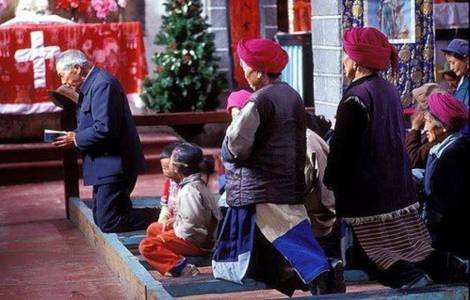
by Marta Zhao
Lhasa (Agenzia Fides) - The China News Service (CNS) (chinanews.com.cn) describes the Catholic community of Yanjing as an "oasis of coexistence" between religions and a "place of encounter" between cultures Catholic community in the Tibet Autonomous Region. The second largest news agency of the People's Republic of China, which disseminates news in Chinese and English, recently posted a detailed report on the "Tibetan community" online. The agency points out that the church building's architectural features also combine Tibetan and Gothic elements, representing a fusion of different cultural traditions. But above all, the details and news collected in the report convey a vivid and evocative image of the small church community that profess faith in Jesus on the Roof of the world, where even Christian liturgical celebrations become an occasion for fraternal coexistence with fellow countrymen, the majority of whom are Buddhists.
The focus of the article is around the figure of Magdalene, the consecrated lay woman who for the past 26 years has de facto custody of the church. Magdalene rings the bells each day, leads the community's daily prayer, recited in the Tibetan language, and also acts as a "tour guide" for visitors from outside when necessary. Magdalene also assists with devotion and concern the priests who come from Yunnan or other provinces to celebrate masses especially on the occasion of liturgical solemnities since there is no longer a permanent presence of a priest in the parish.
The story of Magdalene is not limited to describing the unique way in which the bond of fraternity that binds Tibetan Catholics to their fellow Buddhists is manifested. At Christmas, the more than 520 baptized of the 70 Catholic families who attend the parish also involve the rest of the population in the celebrations for the birth of Jesus. In the morning, after the solemn liturgical celebration, everyone gathers to eat the local cuisine. In the afternoon, Buddhists also help decorate the church with Christmas decorations. After dinner, everyone dresses up in traditional clothes to take part in a feast with songs and dances, celebrating Jesus.
Similarly, Catholics participate in the Tibetan Buddhist festivals in December. "Now - Magdalene says - it happens that both Buddhists and baptized Catholics live in the same family, and on the walls of their houses we find images of Jesus and Mary, together with those of Buddha". Magdalene also took care of the vineyards that had been planted there by the missionaries. She sees this as an eloquent sign that the seed of Christianity had long since been planted in Tibetan land. And when she walks among the vines, she rejoices when she encounters Catholics holding rosaries and devout Buddhists twirling prayer beads. The sound of the church bell under the cross mixes with the sound of the Tibetan prayer flags from the cloth woven in the five colors of the valley and the river.
The CNS report on today's peaceful coexistence is of particular importance when considering history in the light of the many painful events that marked the preaching of the Gospel in Tibet in the past. The first attempts to preach the gospel in Tibet date back to Franciscan missionaries in the 14th and Jesuits in the 17th century. More recently, the records preserved in the archives of the Society for Foreign Missions (Missions Etrangères de Paris, Mep) tell of missionary initiatives on the roof of the world from the mid-19th century by the French missionaries (who also established the church at Yerkalo in 1855) and later by the Augustinian Canons of Great St. Bernard (Switzerland).
In the accounts of this period, Tibet appears as a harsh land where British and Russian colonial interests, incursions by Chinese "warlords" and the servitude of the Lamaist politico-religious feudal system intermingle. The missionaries' accounts describe the desecration of churches and chapels, the confiscation of property, and the forced apostasy of Tibetans who converted to Christianity, whose children were forced to serve as monks in llama monasteries. According to the historian of Eastern Christianity Jean Charbonnier, more than half of the 44 missionaries who have died in Tibet since 1869 were murdered on the orders of the lamas. Still in 1946, the church in Yerkalo was also devastated, and the parish priest at the time, the Swiss Maurice Tornay, was killed while on his way to Lhasa with two companions to meet with the Dalai Lama to demand tolerance and the return of the mission from which he had been expelled. Tornay was beatified as a martyr "in odium fidei" by Pope John Paul II on May 16, 1993. (Agenzia Fides, 20/2/2023)